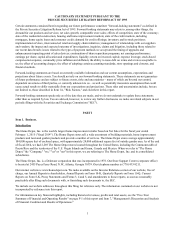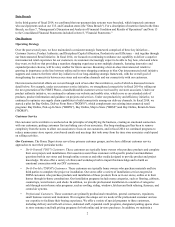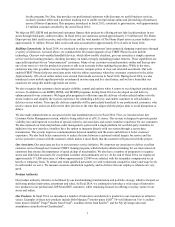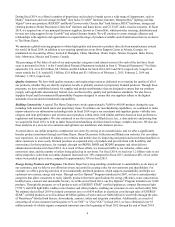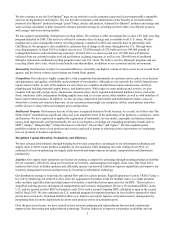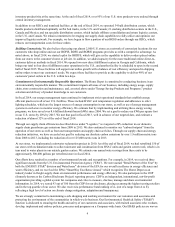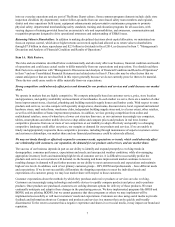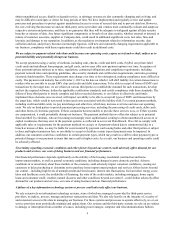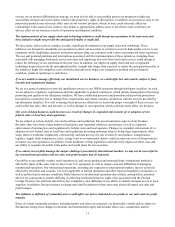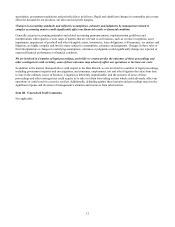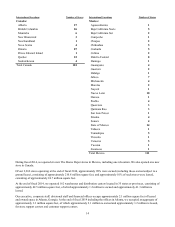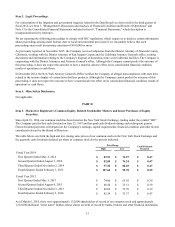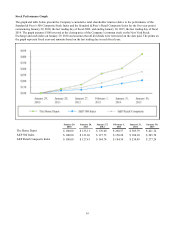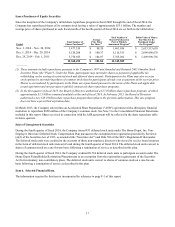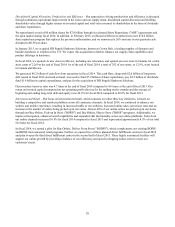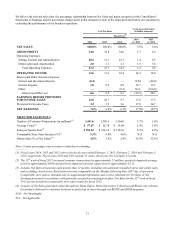Home Depot 2014 Annual Report Download - page 16
Download and view the complete annual report
Please find page 16 of the 2014 Home Depot annual report below. You can navigate through the pages in the report by either clicking on the pages listed below, or by using the keyword search tool below to find specific information within the annual report.11
execute on our product differentiation strategy, we must also be able to successfully protect our proprietary rights and
successfully navigate and avoid claims related to the proprietary rights of third parties. In addition, an increase in sales of our
proprietary products may adversely affect sales of our vendors' products, which, in turn, could adversely affect our
relationships with certain of our vendors. Any failure to appropriately address some or all of these risks could have an
adverse effect on our business, results of operations and financial condition.
The implementation of our supply chain and technology initiatives could disrupt our operations in the near term, and
these initiatives might not provide the anticipated benefits or might fail.
We have made, and we plan to continue to make, significant investments in our supply chain and technology. These
initiatives are designed to streamline our operations to allow our associates to continue to provide high quality service to our
customers, while simplifying customer interaction and providing our customers with a more interconnected retail experience.
The cost and potential problems and interruptions associated with the implementation of these initiatives, including those
associated with managing third-party service providers and employing new web-based tools and services, could disrupt or
reduce the efficiency of our operations in the near term. In addition, our improved supply chain and new or upgraded
technology might not provide the anticipated benefits, it might take longer than expected to realize the anticipated benefits, or
the initiatives might fail altogether, each of which could adversely impact our competitive position and our financial
condition, results of operations or cash flows.
If we are unable to manage effectively our installation service business, we could suffer lost sales and be subject to fines,
lawsuits and reputational damage.
We act as a general contractor to provide installation services to our DIFM customers through third-party installers. As such,
we are subject to regulatory requirements and risks applicable to general contractors, which include management of licensing,
permitting and quality of our third-party installers. We have established processes and procedures that provide protections
beyond those required by law to manage these requirements and ensure customer satisfaction with the services provided by
our third-party installers. If we fail to manage these processes effectively or to provide proper oversight of these services, we
could suffer lost sales, fines and lawsuits, as well as damage to our reputation, which could adversely affect our business.
Our costs of doing business could increase as a result of changes in, expanded enforcement of, or adoption of new
federal, state or local laws and regulations.
We are subject to various federal, state and local laws and regulations that govern numerous aspects of our business.
Recently, there have been a large number of legislative and regulatory initiatives and reforms, as well as expanded
enforcement of existing laws and regulations by federal, state and local agencies. Changes in, expanded enforcement of, or
adoption of new federal, state or local laws and regulations governing minimum wage or living wage requirements, other
wage, labor or workplace regulations, cybersecurity and data privacy, the sale of some of our products, transportation,
logistics, supply chain transparency, taxes, energy costs or environmental matters could increase our costs of doing business
or impact our store operations. In addition, recent healthcare reform legislation could adversely impact our labor costs and
our ability to negotiate favorable terms under our benefit plans for our associates.
If we cannot successfully manage the unique challenges presented by international markets, we may not be successful in
our international operations and our sales and profit margins may be impacted.
Our ability to successfully conduct retail operations in, and source products and materials from, international markets is
affected by many of the same risks we face in our U.S. operations, as well as unique costs and difficulties of managing
international operations. Our international operations, including any expansion in international markets, may be adversely
affected by local laws and customs, U.S. laws applicable to foreign operations and other legal and regulatory constraints, as
well as political and economic conditions. Risks inherent in international operations also include, among others, potential
adverse tax consequences, greater difficulty in enforcing intellectual property rights, risks associated with the Foreign
Corrupt Practices Act and local anti-bribery law compliance, and challenges in our ability to identify and gain access to local
suppliers. In addition, foreign currency exchange rates and fluctuations in those rates may adversely impact our sales and
profit margins.
The inflation or deflation of commodity prices could affect our prices, demand for our products, our sales and our profit
margins.
Prices of certain commodity products, including lumber and other raw materials, are historically volatile and are subject to
fluctuations arising from changes in domestic and international supply and demand, labor costs, competition, market


